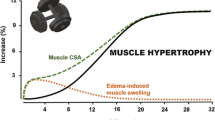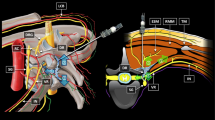Abstract
Purpose
Long-term use of rosuvastatin may be associated with myotoxicity. Statins are one of the groups commonly found to be associated with neuromuscular weakness. The present study was designed to investigate the interaction between rosuvastatin and rocuronium in vivo by using a sciatic-gastrocnemius nerve-muscle preparation of rat.
Methods
In our study groups, animals received rosuvastatin 2 mg/kg for 14 and 28 days. Train of four (TOF) stimulation was applied to the sciatic nerve, and gastrocnemius muscle contractions were recorded in Wistar albino rats. Intravenous infusion of rocuronium was given until the twitch responses were abolished. We ultimately compared the effective dose required for a desired effect in 95% of the population (ED95), duration 25 %, deep block, recovery index, and time for returning of TOF ratio to 0.9 between the active control and study groups.
Results
Chronic administration of rosuvastatin at a dose of 2 mg/kg for 28 days significantly reduced the ED95 of rocuronium as compared to the active control group. Deep block and duration 25 % were increased by 3.5 and 2.5 times, respectively, compared to the active control group. The spontaneous recovery of neuromuscular block was delayed, as evidenced by the prolonged recovery index and increase in time required for a return of the TOF ratio to 0.9.
Conclusion
The neuromuscular blocking potency of rocuronium is increased and recovery is delayed in rats that pre-treated with rosuvastatin.

Similar content being viewed by others
References
Schwartz GG, Olsson AG, Ezekowitz MD, Ganz P, Oliver MF, Waters D, Zeiher A, Bernard R, Chaitman BR, Leslie S, Stern T, Myocardial Ischemia Reduction with Aggressive Cholesterol Lowering (MIRACL) Study Investigators. Effects of atorvastatin on early recurrent ischemic events in acute coronary syndromes: the MIRACL study: a randomized controlled trial. JAMA. 2001;285:1711–8.
Jones PH, Davidson MH, Stein EA, Bays HE, McKenney JM, Miller E, Cain VA, Blasetto JW, STELLAR Study Group. Comparison of the efficacy and safety of rosuvastatin versus atorvastatin, simvastatin, and pravastatin across doses (STELLAR* Trial). Am J Cardiol. 2003;92(2):152–60.
Borroni V, Barrantes FJ. Cholesterol modulates the rate and mechanism of acetylcholine receptor internalization. J Biol Chem. 2011;286(19):17122–32.
Hamilton-Craig I. Statin-associated myopathy. Med J Aust. 2001;175(9):486–9.
Bliznakov EG, Wilkins DJ. Biochemical and clinical consequences of inhibiting coenzyme Q biosynthesis by lipid-lowering HMG-Co A reductase inhibitors (statins): a critical overview. Adv Ther. 1998;15:218–28.
Sonoda Y, Gotow T, Kuriyama M, Nakahara K, Arimura K, Osame M. Electrical myotonia of rabbit skeletal muscles by HMG-CoA reductase inhibitors. Muscle Nerve. 1994;17:891–4.
Hochgraf E, Levy Y, Aviram M, Brook JG, Cogan U. Lovastatin decreases plasma and platelet cholesterol levels and normalizes elevated platelet fluidity and aggregation in hypercholesterolaemic patients. Metabolism. 1994;43:59–64.
Westwood FR, Bigley A, Randall K, Marsden AM, Scott RC. Statin-induced muscle necrosis in the rat: distribution, development, and fibre selectivity. Toxicol Pathol. 2005;33(2):246–57.
Bannwarth B. Drug-induced myopathies. Expert Opin Drug Saf. 2002;1:65–70.
Dalakas MC. Peripheral neuropathy and antiretroviral drugs. J Peripher Nerv Syst. 2001;6:14–20.
Klopstock T. Drug incued myopathies. Curr Opin Neurol. 2008;21(5):590–5.
Savarese JJ, Caldwell JE, Lien CA, Miller RD. Pharmacology of muscle relaxants and their antagonist. In: Miller Ronald D, editor. Miller’s Anesthesia. Philadelphia: Elsevier Churchill Livingstone; 2000. p. 412–90.
Maramattom BV, Wijdicks EF. Acute neuromuscular weakness in the intensive care unit. Crit Care Med. 2006;34:2835–41.
Mishra Y, Ramzan I. Interaction between succinylcholine and ranitidine in rats. Can J Anesth. 1993;40:32–7.
Fu C, Mishra Y, Ramzan I. Omeprazole potentiates atracurium and succinylcholine paralysis in vivo in rats. Anesth Analg. 1994;78(3):527–30.
Conor D, Jennifer M. Monitoring of neuromuscular block. Contin Educ Anaesth Crit Care Pain. 2006;6(1):7–12.
Viby-Mogensen Jorgen. Neuromuscular monitoring. In: Miller Ronald D, editor. Miller’s Anesthesia. Philadelphia: Elsevier Churchill Livingstone; 2000. p. 1351–66.
Saitoh Y, Toyooka H, Amaha K. Recoveries of post-tetanic twitch and train-of-four responses after administration of vecuronium with different inhalation anaesthetics and neuroleptanaesthesia. Br J Anaesth. 1993;70:402–4.
Ghosh MN. Toxicity studies. In: Ghosh SK, editor. Fundamentals of experimental pharmacology. Kolkata: Hilton & company; 2011. p. 165–72.
Bersot TP. Drug therapy for Hypercholesterolemia and Dyslipidemia. In: Laurence LB, Parker KL, editors. Goodman and Gilman’s The Pharmacological Basics of Therapeutics. New York: The McGraw-Hill Companies, Inc; 2011. p. 877–908.
Sidaway J, Wang Y, Marsden AM, Orton TC, Westwood FR, Azuma CT, Scott RC. Statin-induced myopathy in the rat: relationship between systemic exposure, muscle exposure and myopathy. Xenobiotica. 2009;39(1):90–8.
McTaggart F, Buckett L, Davidson R, Holdgate G, McCormick A, Schneck D, Smith G, Warwick M. Preclinical and clinical pharmacology of rosuvastatin, a new 3-hydroxy-3-methylglutaryl coenzyme A reductase inhibitor. Am J Cardiol. 2001;87(Suppl):28B–32B.
Magorian T, Wood P, Caldwell J, Fisher D, Segredo V, Szenohradszky J, Sharma M, Gruenke L, Miller R. The pharmacokinetics and neuromuscular effects of rocuronium bromide in patients with liver disease. Anesth Analg. 1995;80(4):754–9.
Pierno S, Didonna MP, Cippone V, De Luca A, Pisoni M, Frigeri A, Nicchia GP, Svelto M, Chiesa G, Sirtori C, Scanziani E, Rizzo C, De Vito D, Conte Camerino D. Effects of chronic treatment with statins and fenofibrate on rat skeletal muscle: a biochemical, histological and electrophysiological study. Br J Pharmacol. 2006;149(7):909–19.
Brannigan G, Hénin J, Law R, Eckenhoff R, Klein ML. Embedded cholesterol in the nicotinic acetylcholine receptor. Proc. Nat. Acad. Sci. USA. 2008;105:14418–23.
Grajales-Reyes GE, Báez-Pagán CA, Zhu H, Grajales-Reyes JG, Delgado-Vélez M, García Beltrán WF, Luciano CA, Quesada O, Ramírez R, Gómez CM, Lasalde-Dominicci JA. Transgenic mouse model reveals an unsuspected role of the acetylcholine receptor in statin induced neuromuscular adverse drug reactions. Pharmacogenomics J. 2013;13(4):362–8.
Borroni V, Baier CJ, Lang T, Bonini I, White MM, Garbus I, Barrantes FJ. Cholesterol depletion activates rapid internalization of submicronsized acetylcholine receptor domains at the cell membrane. Mol Membr Biol. 2007;24(1):1–15.
Zamir O, Charlton MP. Cholesterol and synaptic transmitter release at crayfish neuromuscular junctions. J Physiol. 2006;571(Pt 1):83–99.
Turan A, Mendoza ML, Gupta S, You J, Gottlieb A, Chu W, Saager L, Sessler DI. Consequences of Succinylcholine Administration to Patients Using Statins. Anesthesiology. 2011;115(1):28–35.
Acknowledgments
The authors would like to thank Dr. Tejas K. Patel, Assistant Professor, Pharmacology, GMERS Medical College, Gotri, Vadodara, Gujarat, India, and Dr. Premila S. Jha, Associate Professor, Anesthesiology, Govt. Medical College, Bhavnagar, Gujarat, India, for critically scrutinizing the manuscript.
This work was supported by the Indian Council of Medical Research (ICMR), New Delhi, vide letter no. 3/2/2012/PG- thesis-HRD: dated—04/04/2012.
Conflicts of interest
The authors declare that they have no conflicts of interest to report.
Author information
Authors and Affiliations
Corresponding author
About this article
Cite this article
Panchasara, A.K., Patel, J.C., Vadgama, V.K. et al. Interaction between rosuvastatin and rocuronium in rat sciatic-gastrocnemius nerve-muscle preparation. J Anesth 28, 727–732 (2014). https://doi.org/10.1007/s00540-014-1792-z
Received:
Accepted:
Published:
Issue Date:
DOI: https://doi.org/10.1007/s00540-014-1792-z




